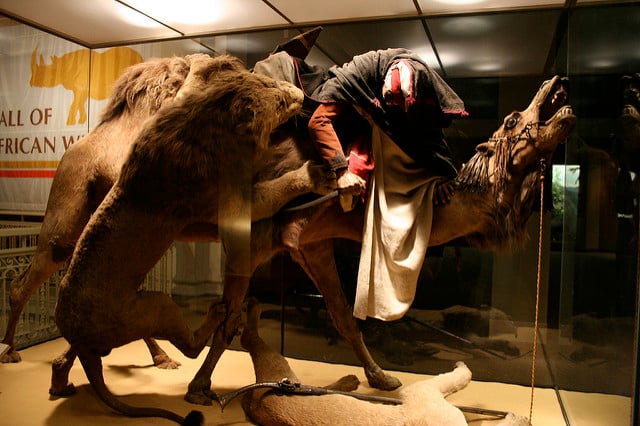Art World
Real Human Skull Discovered in Taxidermy Display at Carnegie Museum of Natural History
A museum official suggests it was pilfered from Parisian catacombs during the 1860s.

A museum official suggests it was pilfered from Parisian catacombs during the 1860s.

Caroline Elbaor

For over 150 years, the taxidermy display “Arab Courier Attacked by Lions” has sat in Pittsburgh’s Carnegie Museum of Natural History, shocking audiences with its unsettling depiction of a man riding a camel while simultaneously fighting off two vicious Barbary lions.
Now, museum-goers have even more reason to react like that to the diorama, as it has been discovered that the figure of the man contains an actual human skull.
During a recent restoration, a CT scan of the display confirmed that the work, including its camel and lions, is comprised of “natural” materials—in what can only be a euphemism for the somewhat gruesome skull.
“The mannequin is purely a mannequin … except for the skull,” conservator Gretchen Anderson told The Tribune-Review. “It’s why the human face is as accurate as it is,” she added. “It’s an amazing piece.”
Prior to its restoration, museum officials were aware of the animals’ bones and human teeth in the diorama, but remained oblivious to the presence of the man’s skull.
According to the The Tribune Review, the discovery sparked an ethical debate regarding reburial, but the decision was ultimately made to keep the piece as is, since the skull’s origin remains a mystery.
The diorama was first displayed at the Paris Exposition Universelle of 1867, where it made waves before being sold to the Museum of Natural History in New York, and finally, to Andrew Carnegie in 1899. Anderson theorizes that somebody “went down to the catacombs in Paris” and snagged the skull prior to its Parisian unveiling.
For nine months, the taxidermied piece has been undergoing restoration; this past Saturday, the diorama returned to its place in the museum under a new name, “Lions Attacking a Dromedary.”
“We’ve talked to hundreds of people. Everybody remembers it. Everybody talks about it. Kids love it,” Anderson said. “This is very iconic of this place.”